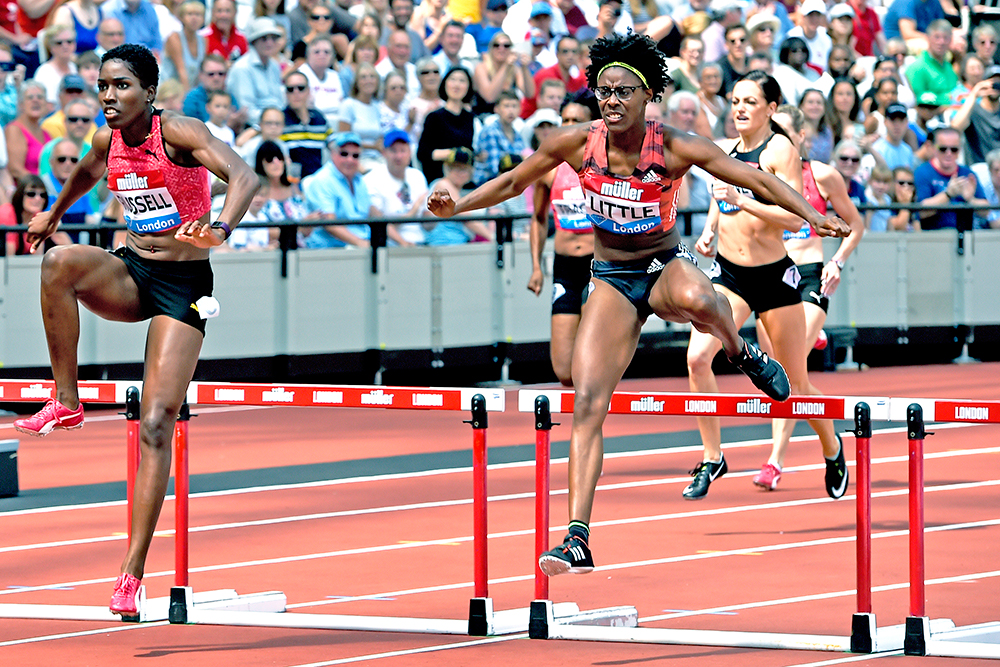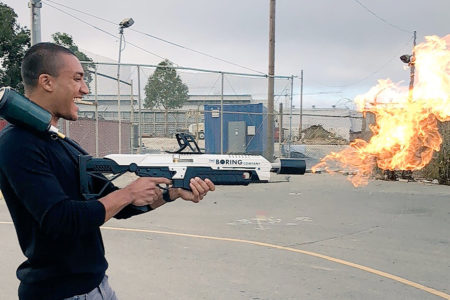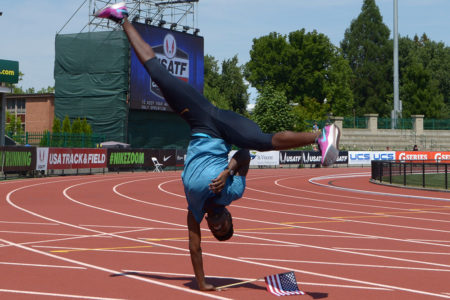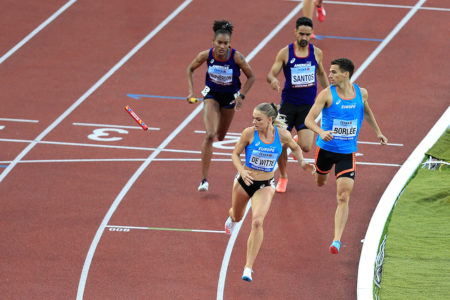
It’s late August and Shamier Little is on the road at the Birmingham Diamond League, trying to deal with English cuisine. She finds herself grabbing Caribbean food every chance she gets. “The Caribbean food is something that can be trusted,” she explains. “It’s not fast food. It’s kind of healthy. My Caribbean friends eat it all day; I love their food so I’m just going to eat this while I’m here.” She pauses, “But… having beans for breakfast is just like the weirdest thing.”
The plight of a world-class hurdler who hates traveling: “It’s not fun at all. The least exciting thing about this profession is just packing and moving all the time. ‘Oh, do I pack 5 shorts or do I pack 7 shorts for the time that I’ll be here? No, I’ve got to calculate the time I’ll be traveling. I won’t be wearing these shorts or this shirt.’ I hate traveling so much. Lugging around a heavy book-bag and a suitcase and then, you know, trying to navigate through the airport is definitely something I don’t like.”
Yet something’s different this year for the 23-year-old Texas A&M alum: “It’s not taking too much of a toll on my body because even if it is, mentally I’m just so excited to get to the next race that all of that doesn’t even matter.”
Shamier Little is on fire this season. Runner-up at Bislett in 53.94. USATF champ in 53.61. Razor-thin Diamond League wins in Lausanne and London. NACAC champion in 53.32, her No. 2 time ever. What’s going on? “I’m more excited about my season than I have been in the past,” she reveals. “Just being on the circuit, having learned a lot this being my third year, I’m kind of looking at it and tackling it differently.”
Part of the recipe is a coaching change and a move. After working with A&M’s Vince Anderson since she finished her prep days in Chicago, she moved to Fayetteville this summer to train under Arkansas assistant Chris Johnson. “I was kind of not knowing what to expect,”she says, “but once I got settled in and got really transitioned… I really enjoy working with the coach. I like the girls in the training group.”
The move follows several years of sparkling promise and broken dreams. When Little decided to bypass her remaining NCAA eligibility at A&M in ’16 after winning three straight NCAA 400H crowns—and a World Championship silver—the sky was the limit. Then, weeks after her final NCAA win in a PR 53.51, she foundered at the Olympic Trials and was unable to get out of her semi. A few days later she tweeted, “I never want my heart to be this broke again.”
She recovered and won the Weltklasse at the end of the summer in 53.97, and then threw everything into training for the ’17 Worlds. The next summer she took 2nd at the ’17 USATF in a brilliant PR of 52.75, just 0.11 behind Olympic champion Dalilah Muhammad. In Europe, however, she couldn’t put it together. She didn’t make it past the semis at Worlds.
“There was some certain stuff that was going on, where I expected that maybe this isn’t going to happen and so I wasn’t particularly frustrated,” she says. “It wasn’t a situation where it was like, ‘I’m doing all of this right, right, right and it’s not coming together.’ I was pretty much doing things all a little wrong leading to up to that. I kind of expected it. You don’t want to be the one that doubts herself. That was what it was.”
Her professional career to this point, she says, “was a very, very tough experience. I was getting really frustrated even though my training sessions were going well.” The good races weren’t quite enough to make up for the disappointments. “Finally coming out and showing that I am fit, I can run that 53. It’s all just mental and then at the same time it’s just not enough. I couldn’t just let this be like, ‘Okay, I did good, I’m good.’ It’s like, ‘No, I’m not good.’
“I’d gotten tired of it,” she continues. “I thought of shutting my season down early or just passing on a race or two, but I had never thought about quitting the sport altogether. I kind of felt like I was out of love with it, and there was nothing I could do about it. I was just like, ‘But I’m not ready to transition into the next stage in my life, so I have to deal with it.’ I had to definitely work through it. If I don’t feel like running, I definitely got to get the run in because something good might happen and I might be proud of myself.
“It was like, ‘Oh, you did this well with these negative thoughts. Imagine when you flip your thought process around, what could happen!’”
Little says part of the challenge was simply about growing up. Another part was learning how to be more independent. “The toughest part was learning how to be your own coach. Being in the college system, my coach is a college coach before he is a professional coach. So being used to having him in my ear for 3 years and to have him not there at some meets that are, you know, they’re actually very important. “Then it was kind of like tough to get myself through the training sessions and give myself feedback. The most difficult part about being pro was transitioning to being without a coach [at times] because I’m super clingy with all of my coaches that I’ve ever had. I’ve always needed them there every step of the way.”
This year, she finally has her college education behind her (Agricultural Leadership—will she ever use the degree? “No,” she says quickly). More importantly, she’s figured out something about herself. “I’m resilient. Very, very resilient,” she says. “I’ve always known that, but it’s been really put to the test over these past 3 years. I’ve figured out I can bounce back from anything. I realized that I am one of the best in this event at this moment. I can be very independent when I’m put in a position where I have to be doing something on my own.”
And Little is hungrier than ever. She won Lausanne by 0.05 over Janieve Russell. She won London by 0.01 over the Jamaican. The NACAC gold? By 0.49 over Russell once again. “I guess we have a little rivalry going on,” she says. “I can’t call it a rivalry. But lately these past few races we’ve been neck-and-neck and that’s really like honestly really thrilling for me. I enjoy every moment.” In each race, she says, “It’s like the fatigue is setting in and I’m like, ‘OK, I want to win.’ And I’m just fighting through that and trying to get to the line and just get it over with. That’s my will. I’m just like, ‘I’ve got to get to this line.’”
The 400H rivalry that’s on the minds of all the world’s high-end performers involves wunderkind Sydney McLaughlin, with whom Little shares No. 9 on the all-time world list. Little has faced her 3 times so far, and won 2. “Um, I don’t know what other hurdlers are thinking, and I just, I don’t see age as anything because I wasn’t running as fast as Sydney was when I was 18, 19 years old,” Little says. “But I was definitely up, you know, and not in my 20s or 19 competing amongst the pros. So it was basically just talent rather than age. And I just, she just; just more talent added to our event, another person that can push us or another person that we can push. We just all push each other.”
The Birmingham DL meet? That didn’t work out. And no, it wasn’t the beans for breakfast: Little got slammed by a monster cold the day before the competition. So she packed her suitcase and went home to get ready for the DL Final and the Continental Cup (where she and Russell would be teammates on the Americas squad). “I have a cold,” she tweeted on her way home the next day. “And I woke up from one of my several naps, and I actually shed a tear thinking about how I’m actually snotty-nosed on this plane like this.”
In Zürich, her 54.21 earned her a runner-up finish behind Dalilah Muhammad’s 53.88. Then came the season closer at the Continental Cup in Ostrava. She finished fast in 53.86 but this time Russell got there a step earlier in 53.62. The long season was finally over.
“I don’t even want to look at another plane after today,” she tweeted.
Looking beyond, there’s the World Championships in ’19, and then the Tokyo Olympics. But Little’s not talking about those: “Right now, I’m just focusing on this season. I don’t want to get too ahead of myself and I don’t want to get too caught up in the past.”
That plan seems to be working.






